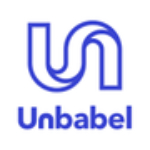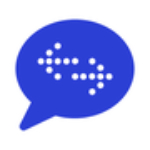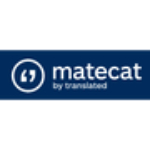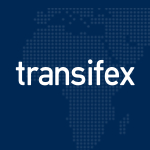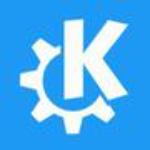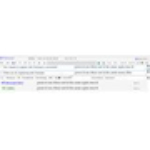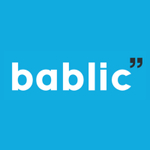TechnologyCounter provides genuine, unbiased real user reviews to help buyers make informed decisions. We may earn a referral fee when you purchase through our links, at no extra cost to you.
List of 15 Best Computer Assisted Translation Software
Showing 1 - 15 of 22 productsUnbabel is a language translation platform that connects businesses and organizations with a global community of translators. With its user-friendly interface, fast turnaround times, and competitive pricing, Unbabel is reshaping the way companies com...Read Unbabel Reviews
Phrase a powerful software designed to revolutionize your writing experience. With its user-friendly interface and innovative features, Phrase helps writers of all levels save time and produce high-quality content. Say goodbye to tedious editing and...Read Phrase Reviews
EasyTranslate is a solution for fast and accurate translations. With its user-friendly interface technology, EasyTranslate makes communicating in different languages effortless. Say goodbye to language barriers and welcome a smoother and more efficie...Read EasyTranslate Reviews
MateCat is a translation tool designed to streamline the translation process and enhance collaboration among translators. With its user-friendly interface features, MateCat empowers users to translate faster and more accurately, allowing them to deli...Read MateCat Reviews
Transifex is a dynamic software that allows individuals and businesses to easily manage their translation projects. With its user-friendly platform, teams can collaborate, track progress, and deliver high-quality translations efficiently. Get ready t...Read Transifex Reviews
Bohemicus is a software designed to streamline your business processes and boost productivity. With its innovative features and user-friendly interface, Bohemicus is the perfect solution for businesses of all sizes. Say goodbye to tedious manual task...Read Bohemicus Reviews
Accelerate your global expansion with Lingohub, the all-in-one translation and localization management platform. Designed with innovative features, a user-friendly interface, and tailored solutions, Lingohub ensures a seamless localization experience...Read Lingohub Reviews
Are you tired of struggling to communicate with others who speak a different language? Look no further than Mirai Translate your go-to solution for effortless translation. With its intuitive interface and precise translations, Mirai Translate is revo...Read Mirai Translate Reviews
Lokalize is a and versatile translation tool that empowers businesses and individuals to seamlessly localize their content for global audiences. With its user-friendly interface features, Lokalize streamlines the translation process, saving time and...Read Lokalize Reviews
Lilt is revolutionizing the world of translation with its innovative technology that combines human expertise with artificial intelligence. This powerful translation software allows businesses to break down language barriers and reach a global audien...Read Lilt Reviews
Gespoint Translator is a language tool for seamless communication. With its advanced technology and user-friendly interface, Gespoint Translator offers a convenient solution for all your translation needs. Experience accuracy and efficiency like neve...Read Gespoint Translator Reviews
RWS Language Cloud is an innovative language solution that streamlines translation, terminology management and text analysis. With its advanced features and user-friendly interface, RWS Language Cloud revolutionizes the way businesses handle multilin...Read RWS Language Cloud Reviews
Translation Exchange is a solution for all your translation needs. This powerful software brings together the best of technology and human linguists to help you seamlessly translate your content into multiple languages. Say goodbye to language barrie...Read Translation Exchange Reviews
Transzaar is a software designed to streamline your business processes and enhance productivity. With its advanced features and user-friendly interface, Transzaar simplifies complex tasks and saves valuable time, making it the go-to solution for mode...Read Transzaar Reviews
Bablic, a dynamic and versatile platform, revolutionizes the way websites are translated and localized. With its powerful features interface, it offers a seamless experience for businesses looking to expand globally. From small startups to large corp...Read Bablic Reviews
- What Is Computer Assisted Translation Software?
- Top Reasons Why Businesses Need Computer Assisted Translation Software?
- What Are the Top Key Features of Computer Assisted Translation Software?
- What Are the Top Benefits of Computer Assisted Translation Software?
- What Are the Steps to Choose the Right Computer Assisted Translation Software?
- What Are the Types of Computer Assisted Translation Software for Different Industries?
- What Are the Technology Trends for Best Computer Assisted Translation Software?
- What Are the Deployment Options for Computer Assisted Translation Software?
What Is Computer Assisted Translation Software?
CAT (Computer-Aided Translation) software is a sort of software solution that supports human translators while translating from one language to another. It expedites the process and improves accuracy by comparing previously translated words and phrases with newly received documents.
Computer-assisted translation software recognizes previously translated as well as source language text and stores it in a database. This database is then consulted whenever a human translator works on a new document. This allows the translator to reuse past translations and derive word selections that are relevant to the situation.
Because the machine conducts some of the work for the translator, using computer-assisted translation software involves less human labor than traditional translation methods.
However, this form of software is not intended to eliminate the need for a translation. Its objective is to help them translate faster and more accurately.
Parallel corpora—sets of texts in two different languages—are also used by computer-assisted translation software to better recognize patterns in the source language and identify appropriate translations for a sentence or phrase.
As a result, best computer-assisted translation is frequently employed in the translation of legal, medical, and other highly specialized texts. Overall, machine translation software is an excellent tool for human translators. It expedites the translation process while assuring high-quality translations.
Top Reasons Why Businesses Need Computer Assisted Translation Software?
1. Cost savings on translation because fewer human translators are required.
2. Increased translation accuracy by removing erroneous manual translations.
3. Translation in bulk improves translation speed and efficiency.
4. Document storage and retrieval made simple. 5. Automated translation quality feedback.
6. More easily integrate translated material into websites, applications, and other documents.
7. Improved customer service by responding to multilingual client inquiries more quickly.
8. Provide multiple language versions of documents with a single click.
9. Easier and more efficient translation document analysis.
10. Automated assessment of translation output for adherence to language-specific criteria.
11. Easier access to useful translation datasets and tools.
12. Increased the global appeal of products and services through fast and accurate translations.
13. Access to a variety of language-specific tools and features to aid in translation accuracy.
14. Use AI-assisted linguistic technology to improve translation efficiency.
15. Merging several source language translations into a single unified version.
What Are the Top Key Features of Computer Assisted Translation Software?
The key features of computer-assisted translation software are:
1. Automated Translation Memory (TM): This feature enables CAT software to save and retrieve language translations from a dataset, allowing for quick and accurate translations of repetitive words and phrases.
2. Machine Learning Integration: Machine Learning can be used in CAT software to automate and improve translation operations. This can include breaking text into parts, providing alternate translations, and even translating full pages automatically.
3. Online Search Functionality: Computer-assisted translation software can access several online resources in several languages, such as dictionaries, linguistic databases, and glossaries. This enables the translation of difficult terms and phrases to be done quickly and accurately.
4. Terminology Management: To manage terminology, CAT software uses a combination of automatic and human operations. This helps to ensure consistency and accuracy throughout the translation process.
5. Multilingual Support: Top computer-assisted translation software can be used to translate documents and text from multiple languages into a single language. This is handy for localizing papers for use in different countries.
6. Extensive Collaboration Features: The best CAT tools for translation include a variety of collaboration capabilities, including project tracking tools, version control, and real-time shared editing spaces.
7. Customizable Interface: The CAT translation software user interface is extremely configurable, allowing customers to personalize the translation experience to their requirements.
8. Quality Assurance: CAT tool software can execute a variety of quality assurance checks to verify translation correctness and consistency. This includes grammar and spelling checks, as well as error detection using a pre-defined set of rules.
What Are the Top Benefits of Computer Assisted Translation Software?
1. Increased Translatability: Computer-assisted translation (CAT) software allows for the faster and more accurate translation of more complicated language. This broadens the variety of texts that can be translated efficiently.
2. Efficiency: Because translators can reuse translation memories and other tools, CAT software enables speedier translation and editing procedures, saving time and money.
3. Reduce Human Error: The best computer-assisted translation automates the translation process, reducing the possibility of human error.
4. Quality Control: Top computer assisted translation software assists in ensuring a greater degree of quality control by automatically detecting any faults so that they may be remedied as soon as possible.
5. Customization: Top computer-assisted translation software can be tailored to the demands of a translator, such as language pairs, terminology, and client preferences.
6. Increased Collaboration: The best computer-assisted translation software promotes collaboration among translators by allowing them to assign assignments, discuss comments, and provide feedback.
7. Cost-Effective: Because automation saves time and money, the best computer-assisted translation software is a more cost-effective method for document translation.
8. Improved Memory Bank: Top computer-assisted translation software aids in the creation of a memory bank' of translations that can be reused in subsequent projects.
What Are the Steps to Choose the Right Computer Assisted Translation Software?
1. Determine the features and functionalities you require in a CAT tool- Any computer-assisted translation software you intend to purchase should meet specific requirements for your unique translation job. Format and layout support (DOC, HTML, XML, etc.), localization and internationalization support (for language and culture differences), document comparison features, translation memory support, glossary management, and workflow-tracking support are some of the criteria you may have in mind for a CAT tool.
2. Evaluate different CAT tools- Once you've defined the features and functions you require, look for CAT tools that provide them. There are various popular commercials for the best computer-assisted translation on the market, so narrowing your search to those recommended by your coworkers or peers may be beneficial. Several open-source CAT tools can be useful for smaller projects.
3. Test the CAT tools- Once you've found the CAT translation software you wish to review, it's critical to put them to the test. Most commercial CAT solutions include free trial versions, allowing you to try the features and functionalities to see if they match your requirements.
4. Compare and select the CAT tool- Once you have completed testing the features and functionalities of the various top computer-assisted translation software, compare and contrast the various possibilities and select the best one for your project. Consider usability, pricing, functionality, compatibility with other software, support, and scalability.
What Are the Types of Computer Assisted Translation Software for Different Industries?
Computer Assisted Translation (CAT) software for various industries comes in a variety of flavors, based on the industry's specific needs. Language-specific CAT tools, Machine Translation tools, and Multilingual Business Suite products are the most popular types of CAT for translation.
Language-specific CAT techniques are most commonly employed for single-language documents like legal contracts and business agreements. The best computer-assisted translation is intended to aid translation by utilizing language-specific dictionaries, rules, and grammar, as well as translation memory databases.
Machine Translation tools are utilized for large-scale document translations such as technical reference manuals and user guides. These applications use Automatic Machine Translation (AMT) to help translate text from one language to another rapidly and accurately with minimal human interaction.
Multilingual Business Suite products are intended to assist businesses in managing and automating their translation processes. Top computer-assisted translation software enables users to track several language versions of documents in a single database, as well as manage and generate translations from one language to another, facilitating the easy flow of multilingual information.
What Are the Technology Trends for Best Computer Assisted Translation Software?
The technology underlying computer-assisted translation software has advanced in recent years, with breakthroughs in natural language processing (NLP) and machine learning (ML) methods.
With these improvements, CAT software is becoming more complex in terms of its capacity to capture context and specialize in specific industrial sectors. In particular, the following CAT software trends have emerged:
• Increased dictionary coverage and customization: To effectively capture the intricacies of language, CAT software incorporates larger and more customizable dictionaries that are customized to diverse market groups. This enables the best computer-assisted translation to comprehend the context of the text being translated better, resulting in more accurate translations.
• Improved NLP algorithms: NLP algorithms are being developed to better grasp the structure of language and the syntactic relationships between words in a phrase. The best cat tools for translation to capture human language nuances, enhancing accuracy and enabling more accurate, smarter translations.
• Machine Learning: Machine learning techniques are being utilized to increase translation accuracy and speed. CAT tool software can better understand the context of the text being translated and provide intelligent translations by analyzing and "learning" from previously translated content.
• Automation: Top computer-assisted translation software is becoming more automated, allowing users to enhance productivity and minimize expenses by completing translations more quickly.
What Are the Deployment Options for Computer Assisted Translation Software?
There are numerous ways to use computer-assisted translation software:
1. Cloud-based: With this deployment method, the computer assisted translation software is run on a distant server and users access it over the internet. This is gaining popularity since it eliminates the need for expensive gear and allows users to cooperate and share their translations in real-time regardless of where they are situated.
2. Client-server: The best computer-assisted translation is installed on the user's local computer, but access is controlled to a server. Because the user is not working directly from the cloud, the user has more control over the user data and system data.
3. On-premises: This option entails installing the CAT program on the user's own machine. This involves more hardware and maintenance than the other two alternatives, but it gives the user more control. Users can also tailor their system to their individual requirements while maintaining the essential protection for sensitive data.
